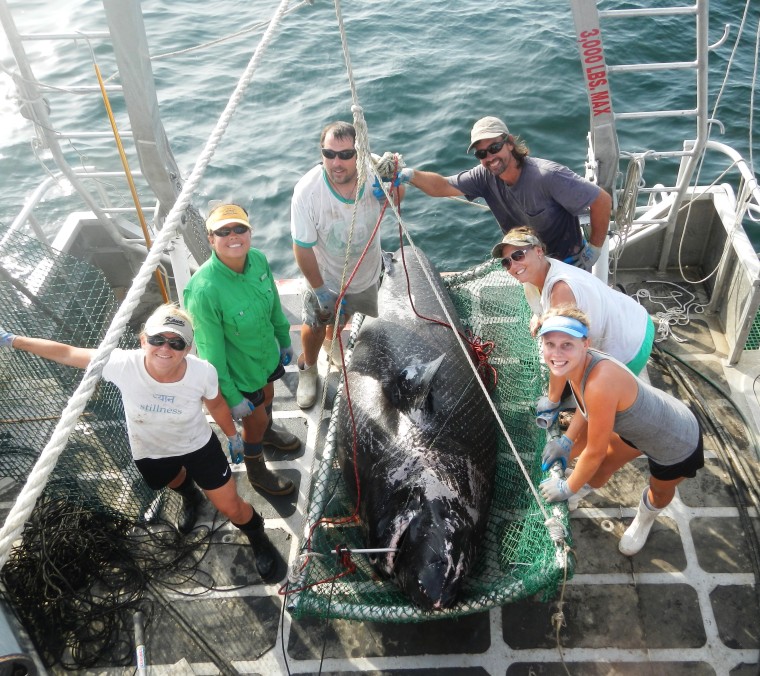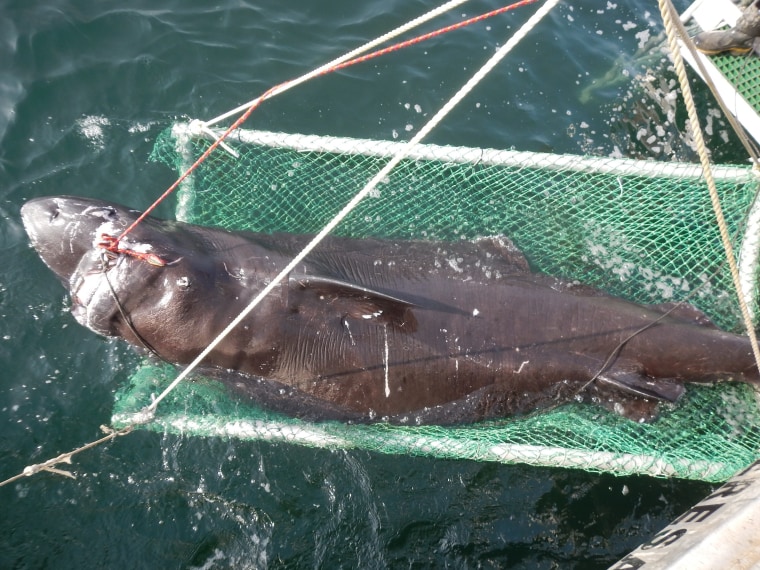A university research crew captured a whopping 12-foot Greenland shark from 6,000 feet below the surface of the Gulf of Mexico, unusually warm waters for the cold-water shark, and a first for such a catch from such depths.
"We weren't expecting something this big," Dean Grubbs, leader of the expedition and a ocean biologist at Florida State University, told NBC News. "Soon as it hit the surface I knew exactly what it was — there aren't too many big black sharks with a long dorsal fin [out there]." It's the first deep-swimming Greenland shark to be captured in the Gulf of Mexico, Grubbs said.
When the crew began pulling back on its nylon line on Aug. 2, they knew something was different. Usually, the line came up empty — not too many creatures live at the depth. But this time, there was a tug at the end of the cabling.
The motorized winch took almost an hour to haul the shark to the ship. It broke the surface "like a whale," and the assistant captain screamed "big fish!" Grubbs said.
Greenland sharks are cold-water swimmers, and usually live in the northern Atlantic, near the Arctic Circle. When they swim south, as they often do, they swim deeper, at depths below 3,000 feet where the water is a bracing 40 degrees Fahrenheit. It's quite a contrast to the Gulf of Mexico's waters, more than 80 degrees Fahrenheit at the surface the day the shark was caught.
Only a handful of researchers, Grubbs among them, have techniques of getting samples of big fish from water that deep.

Grubbs and his team are part of the Deep-C Consortium, a group of ocean biologists who are studying the effect of the 2010 Deepwater Horizon oil spill on the species that live in the Gulf of Mexico.
In the months following the spill, Grubbs says, he'd get questions about how animals living in the Gulf were being affected. "For the most part, we had to answer, we don't know," he said.
The goal of the recent week-long voyage, the sixth expedition Grubbs has led, was to find samples from up to 6,000 feet under the water's surface.
After the shark was hauled on deck, the crew worked on it for hours, well into the night.
Grubbs said they made almost 75 measurements of the fish's body structure. The crew collected samples for genetic analysis, which would confirm which species of sleeper shark the sample was. They also took samples from the shark's muscles, stomach and liver, along with blood and bile, to be shared with labs around the world to understand if and how toxins and chemicals from the 2010 oil spill are incorporated into the shark's body.
There were a few surprises: Grubbs found a six-inch spine of a stingray in the shark's skull, from its jaw up to just below its eye, that probably lodged itself there during what might have been a dinner accident. Among the shark's stomach contents, the researchers found the beaks of squid and the egg case of a skate, a kind of flat, floppy ray.
The shark was alive when it was captured, Grubbs said, but it's not likely it would have survived much longer in the water because of the high temperature.
Nidhi Subbaraman writes about science and technology. You can follow her on Facebook, Twitter or Google+.
